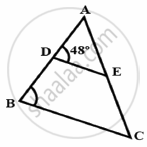Advertisements
Advertisements
Question
In Figure 3, ABCD is a trapezium with AB || DC, AB = 18 cm, DC = 32 cm and the distance between AB and DC is 14 cm. If arcs of equal radii 7 cm have been drawn, with centres A,B, C and D, then find the area of the shaded region.
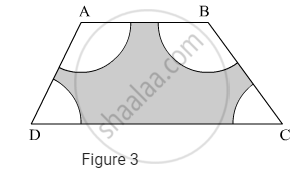
Solution
Here,
Radii of the arcs with centres A, B, C and D = 7 cm
And,
AB = 18 cm
DC = 32 cm
Distance between AB and DC = 14 cm
Area of trapezium ABCD = \[\frac{1}{2}\left( 18 + 32 \right)14\]
= 350 cm2
Now,
Area of unshaded region = Area of sector with central ∠∠A + Area of sector with central ∠∠B + Area of sector with central ∠∠C + Area of sector with central ∠∠D
\[= \frac{\angle A}{360^o} \times \pi \times \left( 7 \right)^2 + \frac{\angle B}{360^o} \times \pi \times \left( 7 \right)^2 + \frac{\angle C}{360^o} \times \pi \times \left( 7 \right)^2 + \frac{\angle D}{360^o} \times \pi \times \left( 7 \right)^2 \]
\[ = \pi \times \left( 7 \right)^2 \left( \frac{\angle A}{360^o} + \frac{\angle B}{360^o} + \frac{\angle C}{360^o} + \frac{\angle D}{360^o} \right)\]
\[ = \frac{22}{7} \times \left( 7 \right)^2 \left( \frac{\angle A + \angle B + \angle C + \angle D}{360^o} \right)\]
\[ = 154\left( \frac{360^o}{360^O} \right) \left( \text{Angle sum property of quadrilateral} \right)\]
\[ = 154 {cm}^2\]
∴ Area of the shaded region = Area of trapezium ABCD − Area of unshaded region
= 350 − 154
= 196 cm2
APPEARS IN
RELATED QUESTIONS
The perimeters of two similar triangles ABC and PQR are respectively 36 cm and 24 cm. If PQ = 10 cm, find AB
The diagonal BD of a parallelogram ABCD intersects the segment AE at the point F, where E is any point on the side BC. Prove that DF × EF = FB × FA
Using Basic proportionality theorem, prove that a line drawn through the mid-points of one side of a triangle parallel to another side bisects the third side. (Recall that you have proved it in Class IX).
In triangle ABC, AD is perpendicular to side BC and AD2 = BD × DC. Show that angle BAC = 90°.
Area of two similar triangles are 98 sq. cm and 128 sq. cm. Find the ratio between the lengths of their corresponding sides.
In each of the given pairs of triangles, find which pair of triangles are similar. State the similarity criterion and write the similarity relation in symbolic form:
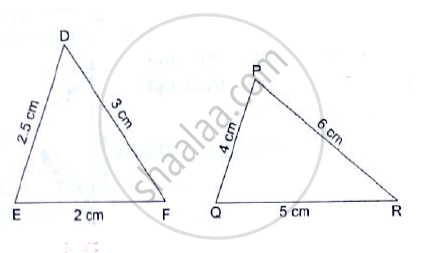
The perimeter of two similar triangles ABC and PQR are 32cm and 24cm respectively. If PQ = 12cm, find AB.
ABCD is a quadrilateral in which AD = BC. If P, Q, R, S be the midpoints of AB, AC, CD and BD respectively, show that PQRS is a rhombus.
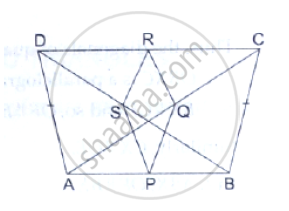
The areas of two similar triangles are `81cm^2` and `49cm^2` respectively. If the altitude of the first triangle is 6.3cm, find the corresponding altitude of the other.
The areas of two similar triangles are `64cm^2` and `100cm^2` respectively. If a median of the smaller triangle is 5.6cm, find the corresponding median of the other.
In the given figure, ∠PQR = ∠PST = 90° ,PQ = 5cm and PS = 2cm.
(i) Prove that ΔPQR ~ ΔPST.
(ii) Find Area of ΔPQR : Area of quadrilateral SRQT.
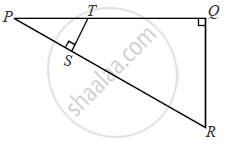
In MBC, DE is drawn parallel to BC. If AD: DB=2:3, DE =6cm and AE =3.6cm, find BC and AC.
The scale of a map is 1 : 200000. A plot of land of area 20km2 is to be represented on the map. Find:
The area in km2 that can be represented by 1 cm2
A model of an aeroplane is made to a scale of 1 : 400. Calculate : the length, in m, of the aeroplane, if length of its model is 16 cm.
In the following figure, point D divides AB in the ratio 3 : 5. Find : `(AD)/(AB)`
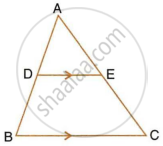
In the figure, given below, AB, CD and EF are parallel lines. Given AB = 7.5 cm, DC = y cm, EF = 4.5 cm, BC = x cm and CE = 3 cm, calculate the values of x and y.
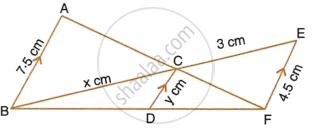
The given figure shows a parallelogram ABCD. E is a point in AD and CE produced meets BA produced at point F. If AE = 4 cm, AF = 8 cm and AB = 12 cm, find the perimeter of the parallelogram ABCD.
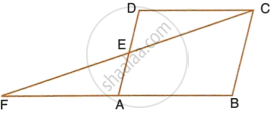
In the given figure ABC and CEF are two triangles where BA is parallel to CE and AF: AC = 5: 8.
(i) Prove that ΔADF ∼ ΔCEF
(ii) Find AD if CE = 6 cm
(iii) If DF is parallel to BC find area of ΔADF: area of ΔABC.
In the figure, PR || SQ. If PR = 10cm, PT = 5cm, TQ = 6cm and ST = 9cm, calculate RT and SQ.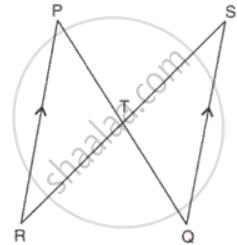
Find the scale factor in each of the following and state the type of size transformation:
Model volume = 200cm3, Actual volume = 8cm3
In the adjacent figure, ∆ABC is right angled at C and DE ⊥ AB. Prove that ∆ABC ~ ∆ADE and hence find the lengths of AE and DE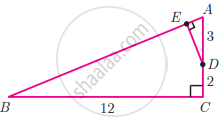
In the figure, which of the following statements is true?
From the figure, prove that ∆SUN ~ ∆RAY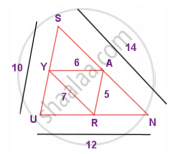
Given ΔABC ~ ΔDEF, if ∠A = 45° and ∠E = 35° then ∠B = ?
If ΔABC ~ ΔLMN and ∠A = 60° then ∠L = ?
ΔABP ~ ΔDEF and A(ΔABP) : A(ΔDEF) = 144:81, then AB : DE = ?
Is the following statement true? Why? “Two quadrilaterals are similar, if their corresponding angles are equal”.
If ΔABC ∼ ΔDEF and ∠A = 48°, then ∠D = ______.
In figure, if AD = 6cm, DB = 9cm, AE = 8cm and EC = 12cm and ∠ADE = 48°. Find ∠ABC.
